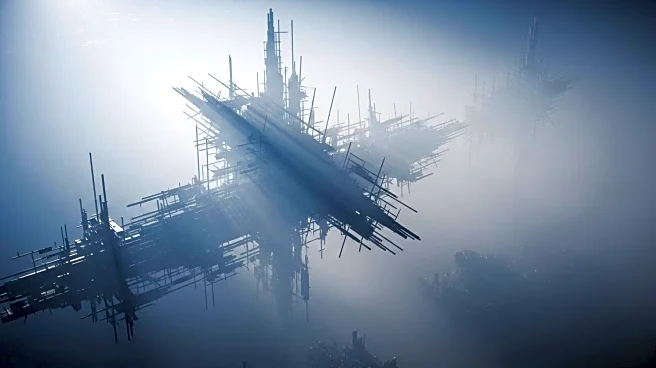What is the story about?
What's Happening?
On August 29th, the Kirk Douglas Theater hosted 'FOG,' a split bill performance featuring ate9 and Jacob Jonas The Company. The show explored dystopian themes through physical movement and live music. Danielle Agami's 'Soon After' premiered with a strong cast, including Billy Barry, Omri Drumlevich, and Gianni Notarnicola. The piece depicted a dystopian future, focusing on family dynamics and themes of body image and consumption. Agami's choreography blended pedestrian movements with technical feats, influenced by the Gaga movement style from Israel's Batsheva Dance Company. The set included benches, trunks, tables, clothing racks, and a giant mirror, creating a crafted world for the dancers. Jacob Jonas' 'Grip' followed after intermission, featuring a simple set design with a glowing orb, chair, table, and fog. The dancers, Alexa Donnelly, Paulina Donnelly, and Jarrett Yeary, showcased acrobatics and breakdance, accompanied by live music from Topu Lyo and Mike Thies. Jonas' choreography emphasized percussive sounds and relationships, exploring abstract themes through intense physicality.
Why It's Important?
The performance of 'FOG' highlights the innovative approaches in contemporary dance, blending narrative and abstract themes with physical movement. Danielle Agami and Jacob Jonas push the boundaries of dance vocabulary, offering audiences a unique experience that challenges traditional dance forms. The exploration of dystopian themes and family dynamics in 'Soon After' reflects societal concerns about body image and consumption, resonating with audiences on a personal level. Meanwhile, 'Grip' showcases the physical prowess of dancers, emphasizing the adaptability and resilience required in extreme situations. These performances contribute to the evolving landscape of dance, encouraging dialogue about the role of art in addressing complex themes.
What's Next?
The success of 'FOG' may lead to further collaborations between Danielle Agami and Jacob Jonas, potentially expanding their reach to new audiences. As contemporary dance continues to evolve, these choreographers might explore additional themes and styles, pushing the boundaries of movement and narrative. The reception of 'FOG' could inspire other artists to experiment with dystopian themes and physicality, influencing future performances and artistic directions. Additionally, the Kirk Douglas Theater may continue to host innovative dance productions, fostering a space for creative exploration and audience engagement.
Beyond the Headlines
The performance of 'FOG' raises questions about the role of dance in reflecting societal issues and personal experiences. By incorporating dystopian themes and family dynamics, the choreographers invite audiences to consider the impact of societal pressures on individual identity and relationships. The use of humor and camp in 'Soon After' challenges traditional narratives, offering a playful yet poignant commentary on life in a dystopian world. Meanwhile, 'Grip' explores the normalization of extreme actions, prompting reflection on how individuals adapt to challenging circumstances. These performances highlight the power of dance to provoke thought and inspire change.
AI Generated Content
Do you find this article useful?

















